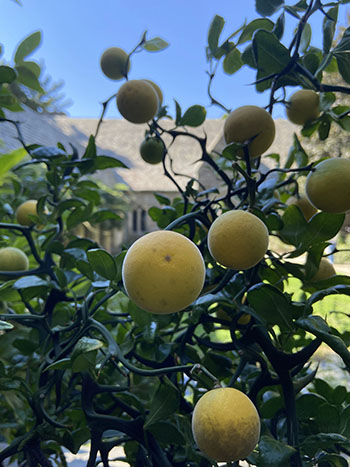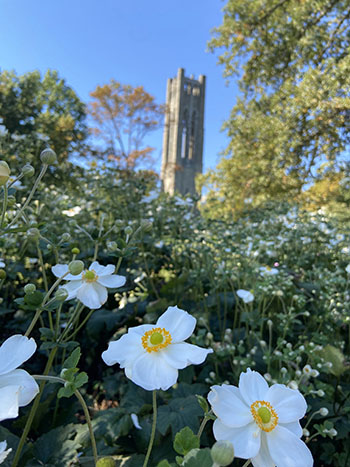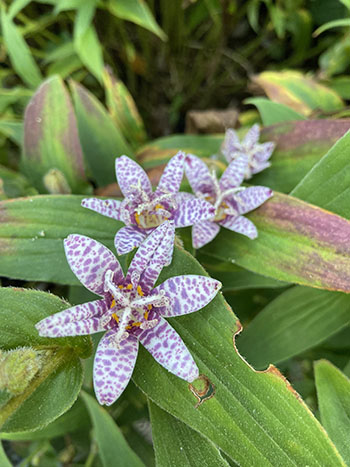
Plants of the Week: October 10

Poncirus trifoliata ‘Flying Dragon’ (hardy orange)
In the stillness of the Theresa Lang Garden of Fragrance lies a beast of a plant. Clad with large, downward curved spikes, sour fruit, and aggressive seeds, the Poncirus trifoliata ‘Flying Dragon’ certainly lives up to its mythical cultivar name. There is a certain beauty in its frightening nature however. When the sun dares to creep up behind this formidable shrub, its sour fruits appear to glow, the fuzzy coating creating a halo around the 3.5-5 inch fruit. The crooked curving nature of this hardy orange is elegant, graceful, and inviting, but remember – look, don’t touch.
The Poncirus trifoliata ‘Flying Dragon’ was introduced to the United States from Japan in 1915 and has since then made a name for itself by being invasive in many states. The edible-when-cooked fruits are aggressive seeders, and this plant is known for taking over understories. However, in the Scott Arboretum we are vigilant with removing the fruits before they fall to the ground.
One of the most cold-hardy cultivars of orange trees, these specimens bloom in the spring with citrus-scented flowers, producing green fruits that transition to yellow that can last well into winter. I cannot in good conscience recommend this tree for the home gardener due to its invasive nature, however it truly is a living piece of sculpture and I invite you to admire this specimen to get a glimpse of this foreboding beauty. Photo credit: M. Rossman

Anemone x hybrida ‘Honorine Jobert’ (Japanese anemone)
First the Lycoris squamigera (surprise lily), then the Colchicum (fall crocus), and now the Anemone! Magill Walk is certainly showing up for the late-summer, early-fall interest! The current star of the iconic Swarthmore walk is the Anemone x hybrida ‘Honorine Jobert’.
Single blooms carefully carried atop wiry stems, rise above attractive mounds of dark green foliage. These flowers have a breezy disposition, adding lightness and airness to the early-fall garden. This herbaceous perennial blooms from August to October and delights viewers with its pure white flowers and contrasting yellow stamens.
Growing in Zones 4-8, the Japanese anemone is versatile in its growing conditions but prefers dappled shade and evenly moist, well-drained soils. Reaching 3-4 feet tall, the Anemone x hybrida ‘Honorine Jobert’ adds great height to a garden bed without obstructing the view of other plants or surrounding areas. Due to their branching nature, the flowers are able to integrate themselves throughout nearby plants without being pushy. I encourage you to take a stroll down, or up, Magill Walk to see this lovely garden favorite. Photo credit: M. Rossman

Tricyrtis hirta ‘Variegata’ (toad lily)
What plant enjoys shade and has interesting foliage? Does this plant also have neat early-fall flowers? Is this plant loved by pollinators? I’m not sure what plant you were thinking of, but what comes to my mind is the Tricyrtis hirta ‘Variegata’ or toad lily.
A day has not gone by when I haven’t sought out the grouping of toad lilies in the Scott Entrance Garden to get a close up view of their orchid-like blooms or to watch the busy bees doting on each flower. It’s a joy to watch the bees land on one of their six showy petals and burrow under their crown-like stamen cluster to access the pouch-like nectaries.
Growing in Zones 4-8 the Tricyrtis hirta ‘Variegata’ emerges in the spring with dark green leaves, accompanied by slender, bright yellow margins. When planted en masse this plant creates wonderfully dense fall foliage that reaches 18-24 inches in height, perfect for cottage gardens or in the middle of borders. And if that isn’t great enough, this plant keeps providing, with its late-summer, early-fall flowers that bloom at leaf bases. The flowers are best when you can appreciate them up close and will last for about three weeks or until a hard frost. The toad lily thrives in average to moist soils, in full to partial shade and certainly brings some joy to my day as I hope it will to yours. Photo credit: M. Rossman





Wendy
Posted at 10:16h, 27 OctoberI first saw Jap anemones and toad lily on a fall trip to England many years ago, before we had them where I gardened in Canada. The agapanthus and kirengeshoma were so beautiful, too, Thanks for highlighting them.